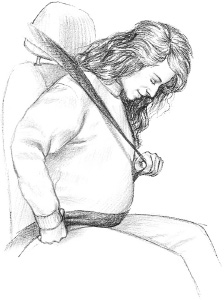Army Policies
During pregnancy, you are
exempt from body composition and fitness testing. You cannot be
deployed overseas. At 20 weeks, you are required to stand at parade
rest or attention for no longer than 15 minutes. At 28 weeks, your work
week is limited to 40 hours a week, 8 hours a day.
Navy Policies
During pregnancy, you are exempt from
body composition and fitness testing. You are not allowed to serve on a
ship after 20 weeks of pregnancy. You are limited to serving duty in
places within 6 hours of medical care. Your work week is limited to 40
hours, and you are required to stand at parade rest or attention for no
longer than 20 minutes.
Air Force Policies
During pregnancy, you are
exempt from body composition and fitness testing. Restrictions are
based on your work environment. If you are assigned to an area without
obstetrical care, your assignment will be curtailed by week 24.
Marine Corps Policies
You will be on full-duty status until a
medical doctor certifies full duty is not medically advised. You may
not participate in contingency operations nor may you be deployed
aboard a Navy vessel. Flight personnel are grounded unless cleared by a
medical waiver. If a medical doctor deems you are unfit for physical training
or you cannot stand in formation, you will be excused from these
activities. However, you will remain available for worldwide
assignments.
Pregnant Marines will not be
detached from Hawaii aboard a ship after their sixth month. If serving
aboard a ship, a pregnant woman will be reassigned at the first
opportunity but no later than by 20 weeks.
U.S. Coast Guard
During pregnancy, you are exempt from
body composition and fitness testing. After 28 weeks of pregnancy, your
work week will be limited to 40 hours. You will not be assigned
overseas. Other duty restrictions are based on your job; however, you
will not be assigned to any rescue-swimmer duties during your pregnancy.
You may not be deployed from the
twentieth week of your pregnancy through 6 months postpartum. You will
not be assigned to any flight duties after your second trimester (26
weeks), and you are limited to serving duty in places within 3 hours of
medical care.
Some General Cautions if You’re in the Military
We know women who get pregnant while on
active duty face many challenges. The pressure to meet military
body-weight standards could have an effect on your health; that’s the
reason these requirements are relaxed during pregnancy.
Work hard to eat healthy foods so your
iron stores and folic-acid levels are adequate. Examine your job for
any hazards you may be exposed to, such as standing for long periods,
heavy lifting and exposure to toxic chemicals. Before receiving any
vaccinations or inoculations, discuss them with your pregnancy doctor.
Any of these factors can impact your pregnancy.
If you are concerned about any of the
above, discuss it with a superior. Changes beyond those described above
may have to be made.
Driving during Pregnancy
It is usually safe to drive during
pregnancy, but it may become uncomfortable for you to get in and out of
the car as pregnancy progresses. However, your increasing size
shouldn’t interfere with your ability to drive.
Many women are confused about whether
they should wear seat belts and shoulder harnesses during pregnancy.
These safety restraints are just as necessary during pregnancy as they
are when you’re not pregnant!

For your protection, and the protection of your developing baby, always wear your safety belt/shoulder harness when driving or riding in a car!
There is no evidence that use of safety restraints increases the chance
of fetal or uterine injury. You have a better chance of survival in an
accident wearing a seat belt than not wearing one.
There is a correct way to wear your
safety belt during pregnancy. Place the lap-belt part of the restraint
under your abdomen and across your upper thighs so it’s snug but
comfortable. Adjust your sitting position so the belt crosses your
shoulder without cutting into your neck. Position the shoulder harness
between your breasts; don’t slip it off your shoulder. The lap belt
can’t hold you safely by itself.